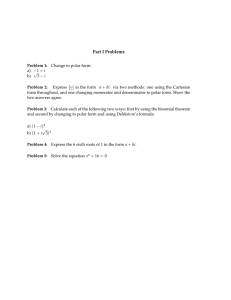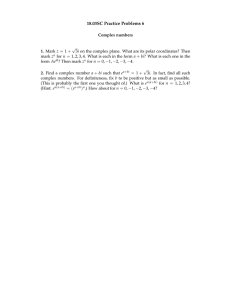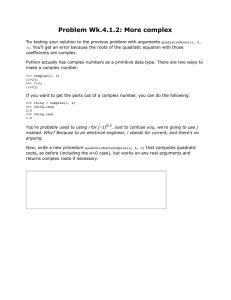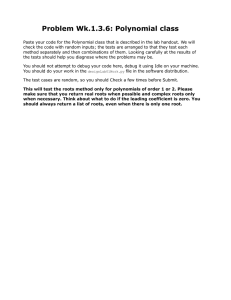Part − + √
advertisement
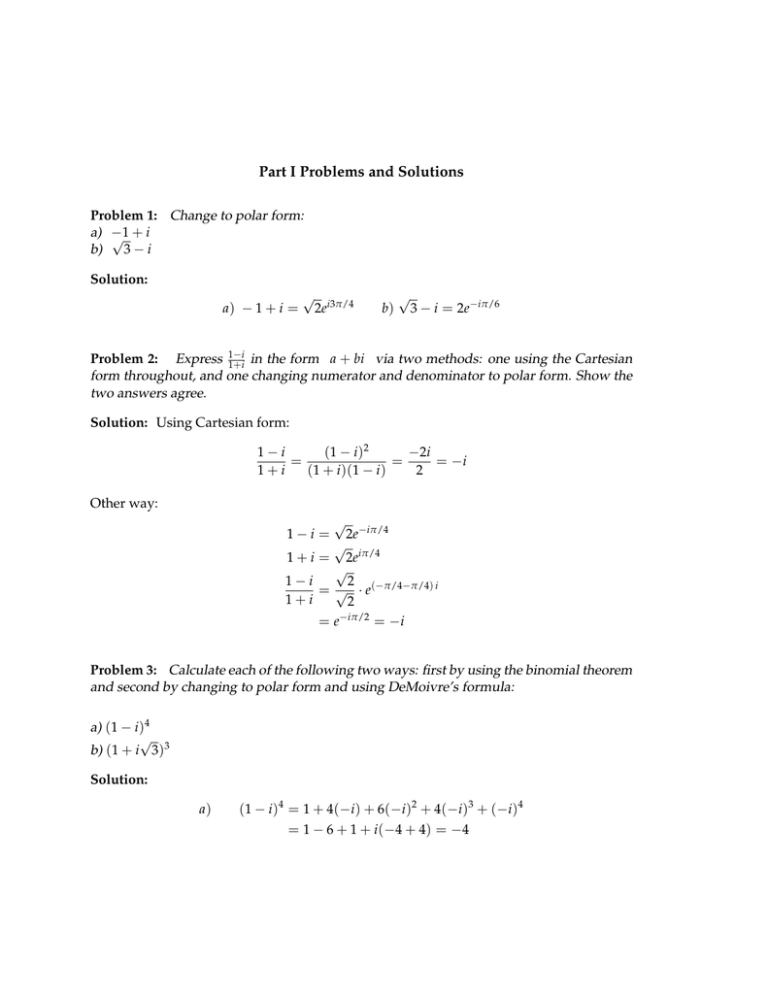
Part I Problems and Solutions Problem 1: Change to polar form: a) − √1 + i b) 3−i Solution: a) − 1 + i = √ 2ei3π/4 b) √ 3 − i = 2e−iπ/6 i Problem 2: Express 11− +i in the form a + bi via two methods: one using the Cartesian form throughout, and one changing numerator and denominator to polar form. Show the two answers agree. Solution: Using Cartesian form: (1 − i )2 −2i 1−i = = = −i 1+i (1 + i )(1 − i ) 2 Other way: 1−i = √ √ 2e−iπ/4 2eiπ/4 √ 1−i 2 = √ · e(−π/4−π/4) i 1+i 2 −iπ/2 =e = −i 1+i = Problem 3: Calculate each of the following two ways: first by using the binomial theorem and second by changing to polar form and using DeMoivre’s formula: a) (1 − i )4 √ b) (1 + i 3)3 Solution: a) (1 − i )4 = 1 + 4(−i ) + 6(−i )2 + 4(−i )3 + (−i )4 = 1 − 6 + 1 + i (−4 + 4) = −4 Part I Problems and Solutions OCW 18.03SC By DeMoivre: √ 2e−iπ/4 √ (1 − i )4 = ( 2)4 e−iπ = 4 · (−1) = −4 1−i = b) √ √ √ √ (1 + i 3)3 = 1 + 3( i 3) + 3( i 3)2 + ( i 3)3 √ √ = 1 + 3i 3 + 3 · (−3) + i3 3 3 √ √ = −8 + i (3 3 − 3 3) = −8 By DeMoivre: √ 1 + i 3 = 2eiπ/3 √ (1 + i 3)3 = 8eiπ = −8 Problem 4: Express the 6 sixth roots of 1 in the form a + bi. iπk/3 where k = 0, 1, 2, · · · , 5. Thus (using Solution: In polar form the sixth √ roots of 1 are e cos(π/3) = 1/2, sin(π/3) = 3/2) the roots in Cartesian form are √ ±1 ± i 3 ±1, and 2 Problem 5: Solve the equation x4 + 16 = 0 √ √ Solution: 4 −16 = 2 · 4 −1 ±1 ± i The 4th roots of −1 are ei(π/4+nπ/2 = √ . They are shown in the figure at right: 2 √ 4 Thus, 2 (±1 ± i ) are the roots of x + 16 = 0. 2 -1 y x MIT OpenCourseWare http://ocw.mit.edu 18.03SC Differential Equations Fall 2011 For information about citing these materials or our Terms of Use, visit: http://ocw.mit.edu/terms.
